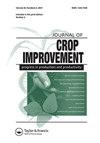Comparison of non-overlapping maize populations of unequal sizes for resistance to maize lethal necrosis
IF 1.5
Q3 AGRONOMY
引用次数: 0
Abstract
ABSTRACT Contrast between marker-assisted backcross (MABC) and doubled haploid (DH) methods in transferring genes for resistance to maize lethal necrosis (MLN) in maize (Zea mays L.) is not well understood. The MLN is caused by co-infection of maize plant by maize chlorotic mottle virus and sugarcane mosaic virus. Two maize panels consisting of four BC3F2 and six DH populations, separately developed through marker-assisted selection from crosses between susceptible CIMMYT lines and MLN-resistant donor parent (KS23-6), were used in the current study. The two populations were of different population structures with unequal sizes. Experiments were conducted under artificial MLN inoculations for two seasons in 2018. Analyses of variance revealed significant variations among genotypes in both panels (p ≤ 0.001). Levene’s and Welch’s tests found that variances and means of the BC3F2 and DH populations were highly unequal (p ≤ 0.001). The study identified genotypes with reduced MLN infections in both populations; however, lower means for MLN severity and area under disease progress curve (AUDPC) values, and higher heritability estimates were obtained in the DH populations than in the BC3F2 populations. Additionally, the DH populations showed higher relative genetic gains for resistance to MLN compared with the BC3F2 populations. The current study detected superiority of DH over MABC populations for breeding for resistance to MLN. Nevertheless, the results observed in the present study warrant further investigations using the same genetic materials with identical population sizes.不等大小非重叠玉米群体对玉米致命坏死的抗性比较
标记辅助回交(MABC)和双单倍体(DH)方法在转移玉米(Zea mays L.)抗玉米致命坏死(MLN)基因方面的对比尚不清楚。玉米萎黄斑驳病毒和甘蔗花叶病毒共同侵染了玉米植株,引起了玉米萎黄斑驳病。本研究使用了由4个BC3F2群体和6个DH群体组成的两个玉米群体,分别通过标记辅助选择从敏感的CIMMYT系和耐mln供体亲本(KS23-6)之间的杂交中开发出来。两个种群的种群结构不同,大小不等。2018年进行了两个季节人工接种MLN的实验。方差分析显示两组基因型之间存在显著差异(p≤0.001)。Levene’s和Welch’s检验发现BC3F2和DH人群的方差和均值高度不相等(p≤0.001)。该研究确定了两种人群中MLN感染减少的基因型;然而,与BC3F2人群相比,DH人群的MLN严重程度和疾病进展曲线下面积(AUDPC)值的平均值较低,遗传力估计较高。此外,与BC3F2群体相比,DH群体对MLN的抗性表现出更高的相对遗传增益。本研究发现DH比MABC群体在MLN抗性育种方面具有优势。然而,在本研究中观察到的结果值得使用相同的遗传物质和相同的群体规模进行进一步的调查。
本文章由计算机程序翻译,如有差异,请以英文原文为准。
求助全文
约1分钟内获得全文
求助全文
来源期刊

Journal of Crop Improvement
Multiple-
CiteScore
3.30
自引率
7.70%
发文量
42
期刊介绍:
Journal of Crop Science and Biotechnology (JCSB) is a peer-reviewed international journal published four times a year. JCSB publishes novel and advanced original research articles on topics related to the production science of field crops and resource plants, including cropping systems, sustainable agriculture, environmental change, post-harvest management, biodiversity, crop improvement, and recent advances in physiology and molecular biology. Also covered are related subjects in a wide range of sciences such as the ecological and physiological aspects of crop production and genetic, breeding, and biotechnological approaches for crop improvement.
 求助内容:
求助内容: 应助结果提醒方式:
应助结果提醒方式:


